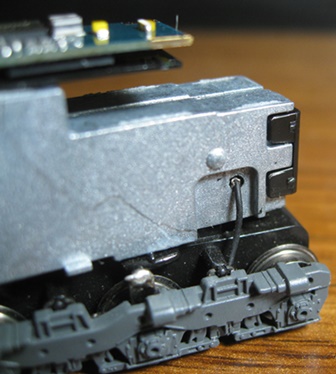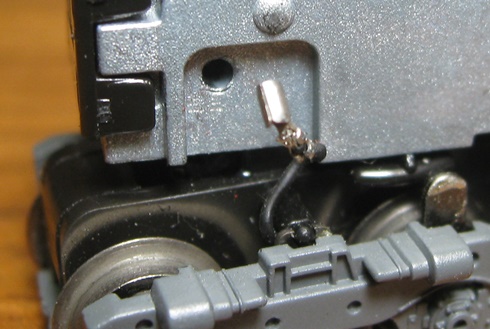



Introduced: 2000 (first release), 2005 (scale speed motor version) and 2018 (DCC-Sound version)
The initial release of these models introduced a couple of new Atlas diesel features - preinstalled Accumate couplers (adios to the Rapidos) and multi-color handrails and steps. As pictured above, these models are available in low-nose and high-nose variants.

The original chassis/mechanism sports all the features one normally associates with "modern" Atlas diesels - IE, split-frame / all-metal chassis, 5-pole / skew-wound motor with dual flywheels, low-friction drive and pickup, bi-directional LED lighting, all-wheel drive and pickup (no traction tires), blackened / low-profile wheels, shell-mounted couplers, all-plastic gearing, etc. The chassis is fully DCC-Ready (and, as pictured above, available with a factory-installed decoder).
Performance on these older models is perfect in every way - smooth, quiet, flawless pickup and throttle response, exceptional pulling power, etc.
Starting with the 2005 release, these models were revised to include Atlas's "scale speed" motor. Also, the LEDs for the headlight and reverse light were changed from yellow/orange to "golden white".
In 2018, the internals were completely redesigned to include support for an ESU LokSound DCC-Sound decoder and accompanying speaker (analog versions and non-sound DCC versions were also part of this release). Instead of using screws and hex nuts to hold the chassis halves together, this new version uses plastic clips on either end of the chassis (the fuel tank and motor saddle also contribute to holding things together) -

Gone are the chassis contact strips that the truck axle-wipers used to rub up against (an Atlas staple since the 1980's). Instead, small wires are soldered to the axle-wipers on the one end and to cylindrical metal plugs (which insert into holes in the chassis) on the other. One of the plugs on mine was actually fairly loose fitting (popping out with little or no effort). But since the shell serves to keep them in their holes, I don't really see it going anywhere once the shell is on. The other three were extremely tight fitting and wouldn't budge when faced with a moderate amount of pulling force (I spared the elbow grease because I didn't want to risk damaging them by really forcing the issue). Each plug has an open seam (lengthwise), so I suppose it's possible to resize them should they wind up getting too loose.


The rest of the internals are more or less the same as before. A five-pole / skew-wound motor spins dual flywheels. In turn, the flywheels spin plastic shafts with notched-cups on the worm side. Said cups spin little ball-and-pin connectors on the wormshafts. Bearing blocks inside of notches in the chassis hold the brass worms in place. A long plastic shield is clipped to the top of the chassis (dunno why - but maybe to prevent short circuits between the decoder and chassis?)

I particularly like the way the circuit boards (and contacts thereto) have been redesigned. Very similar to IMRC's SD40-2 of 2017, metal contacts on the motor saddle transfer current from the main PC board (or decoder) to the motor and to the speaker mounted inside the fuel tank (note that even the non-sound locos come with a speaker). Unlike previous Atlas locos, the main PC board slides in and out of its chassis slots without requiring that one first partially disassemble the chassis (a nicety that Kato has offered for years). The design and placement of the new PC board contacts is also an improvement over previous Atlas diesels (where getting the motor contacts to line up with the contact pads on the PC board was admittedly a bit "hit and miss").
All twelve wheels provide pickup, all six axles are geared, and all gearing is plastic. The wheels are blackened and low-profile. The trucks and fuel tank appear to be the same as on previous versions (in fact, the fuel tank still bears its "2000" copyright stamp). Note that speaker holes in the fuel tank aren't really required since the speaker is positioned such that sound projects upward rather than downward.

According to Atlas, there were no changes to the shell with this release (so, older shells should presumably work with this newer chassis, and vice versa). The shell is all plastic and includes separate detail parts for the windows, numberboards, handrails, sidesills, and horn. Couplers are shell-mounted Accumates.

Performance on this new version is every bit the equal of its predecessors. Out of the box, I didn't have any problems with the wheel-blackening causing any sort of jitteriness. They run very quietly, throttle response is smooth, pickup is flawless, slow speed creep is "one-time-at-a-time" and the top-end speed is realistic (IE, not too fast). Pulling power is strong, with mine comfortably able to haul twenty-five assorted 50' freight cars through curves on level track (and probably a whole lot more than that). No problems with any of the wheels derailing (even on 9.75" radius curves). Overall, just really superb looking and running models.
The sound on the DCC-Sound versions is well rendered and nicely beefy. And for a change, the default settings for volume are quite reasonable. I didn't notice any difference in performance when operating mine with an analog powerpack (IE, they run equally well using DCC or DC control). As seems to be typical with DCC-Sound models these days, the decoders in these locos are programmed to go through a rather protracted sequence of "start up" shenanigans before they start moving (and with similar behavior when slowing down). To eliminate this nonsense (if you're so inclined), simply set CV124 to 0. Also note that the default behavior is for the sound to be off (IE, put the loco on the rails and it won't make a peep). To turn sound on, hit F8.
Features (2018 release) -
- Directional lighting
- Walkway safety tread
- Blackened metal wheels
- Scale speed motor
- Factory-equipped with AccuMate knuckle couplers
- Painted handrails
- Golden-white LEDs
- Atlas Master Gold models feature ESU Loksound decoders
DCC Features -
- Supports all DCC-programming modes
- DCC includes RailCom and RailComPlus, with 14, 28 or 128 speed steps and with 2-digit and 4-digit addressing
- Flexible mapping of function keys F0 to F28
- A total of 6 DCC function outputs are available, and all can be function mapped (disable, brightness, light effects) individually
- Follows all NMRA DCC standards and recommended practices
ESU LokSound Features -
- Over 20 sound effects are available, including engine start-up and shutdown, prime mover sounds through all eight notches, bell, air horn, air compressor,
dynamic brakes and more
- There are up to 16 user-selectable horns, 2 user-selectable bells, and 2 user-selectable synchronized brake squeals
- Manual and Automatic Notching modes with the ability to change modes on the fly are provided for true realism
Prototype -
Between 1964 and 1966, EMD built a total of 360 six-axle 2,500hp SD35 locomotives. An additional 35 steam generator-equipped SDP35 locomotives were also built during this period. These were all part of EMD's 35-Series which also featured the four-axle, 2,250hp GP35 locomotive. All locomotives included the standard EMD 567-series prime mover. A stock model weighed 360,000 pounds, but many roads chose to add weight to increase the locomotive's tractive effort. From the mid-1960s through the 1980s, the SD-35 could be found in road service on both large and mid-sized roads across the US. Today the number of active units has dwindled to a select few, including those operated by regional railroad Montana Rail Link.
Trivia - ICG/IC fans can make an SD28 stand-in by simply taking an Atlas GP38 shell, combining it with an SD35 walkway, and mounting it on an SD35 mechanism (note that it may be necessary to file a small amount of metal off the ends of the frame to get a good fit). Not 100% accurate, but it captures the overall look of a normally aspirated SD35 quite well -
Shell Removal -
Shell removal on these models is pretty simple - just take hold of the fuel tank with one hand and the shell with the other, then just sort of wiggle the shell up and off.
Grade: A (for all versions)